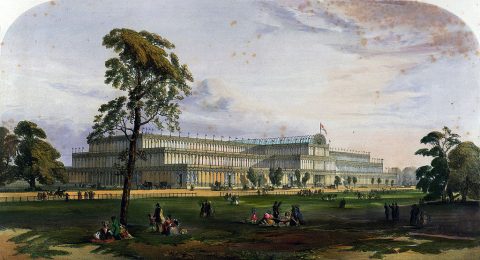In the latest Age of Invention newsletter, Anton Howes explains why the 1951 Festival of Britain failed to reproduce the success of the Great Exhibition of a century earlier, even though it did succeed in other ways:

The Crystal Palace from the northeast during the Great Exhibition of 1851, image from the 1852 book Dickinsons’ comprehensive pictures of the Great Exhibition of 1851
Wikimedia Commons.
… the idea that I tend to get most excited about, which I mentioned only in passing last month, is how we might resurrect the spirit of the nineteenth-century exhibitions of industry.
The best-known of these is undoubtedly the Great Exhibition of the Works of Industry of All Nations of 1851, still famous for its Crystal Palace. Held in Hyde Park, London, it attracted six million visitors, and has been emulated many times since. The World Fairs of today number the Great Exhibition as their first. Yet most people today don’t really appreciate what the Great Exhibition was actually for. They see it as a big, international event, with millions of visitors, who saw all sorts of fancy and exciting things — a chance for Britain, and many other countries since, to show off. The result is that many of the events that seek to capture something of the spirit of the original exhibition — 1951’s Festival of Britain, most of the World Fairs since the Second World War, the Millennium Experience, the 2018 Great Exhibition of the North, and now an upcoming “definitely-not-a-Festival-of-Brexit” (currently branded as Festival UK* 2022) — totally and utterly miss the point.
This is perhaps best illustrated by the runup to the 1951 Festival of Britain. Its proposers in the 1940s saw that the centenary of the Great Exhibition was coming up, so they proposed that there should be something similar to mark it. Yet by doing so, they did things entirely back-to-front. The Great Exhibition had a purpose; the exhibition was just the medium. It was the tool for a specific and sophisticated agenda. The Festival of Britain, by contrast, started with the idea of an exhibition, and then flailed about for a reason why. The government had a vague idea of organising an event to lift the country’s spirits after the Second World War, as well as to have it Britain-focused so as to craft a new national identity as the old empire disintegrated. But as its director-general Gerald Barry put it when they actually started work on the event: “we sat before our blotting pads industriously doodling, in the hope perhaps that a coherent pattern might eventually emerge, on the same principle that if you set down twelve apes before twelve typewriters they will (or so it is said) in the course of infinity type out the complete works of Shakespeare.”
Looking at the build-up to Festival UK* 2022, it’s hard not to get the same impression. The government wanted something to vaguely help craft a post-Brexit identity, on which it is happy to spend well over a hundred million pounds. Yet to make it happen it has funded a “research and development” project: a whole bunch of committees tasked with coming up with ideas of what to actually do (so far, it’s to be “a collection of ten large-scale, public engagement projects”). This is not to say that the event won’t, in some sense, succeed. The 1951 Festival of Britain, after all, was widely lauded. Barry’s twelve apes at their typewriters didn’t quite write Shakespeare, but they did manage to come up with something that many people remembered fondly. Perhaps some of the projects in 2022 will be similarly impressive.
Yet that doesn’t change the fact that the more recent projects miss the point. In fact, I’d say they are the exact inverse of the Great Exhibition. For a start, the 1851 event was entirely self-funded. It had government support, of course, including a cross-party Royal Commission to oversee the team that did the day-to-day running of things, but it raised its money through a public subscription and, when this was insufficient, took out a loan backed by a group of wealthy guarantors. Fortunately, the guarantors never had to pay out, as the event made so much through ticket sales that it was wildly profitable — so much so that the Royal Commission for the Great Exhibition of 1851 still exists. It purchased the 87 acres of land immediately south of the exhibition site, at South Kensington, for a more permanent collection of cultural institutions including many of London’s major museums. It helped fund a subsequent exhibition of industry on that site in 1862 — which actually had even more visitors, though it’s hardly remembered today. And even now, the Royal Commission continues to dispense over £3m every year to students and researchers.
That self-funding was important, I think, because it removed one of the main criticisms faced by modern large-scale events: that they are expensive wastes of taxpayer money on the vanity projects of politicians. The crowd-funding and finding of sufficient guarantors meant that the event needed to be accepted by the public at large, and even had them committed to the project before it had even begun. It necessitated a clear, exciting message from the get-go, rather than a post-hoc rationalisation.
And what was that message? For nineteenth-century organisers, an exhibition of industry was not just some grand display with a certain je ne sais quoi. It was intended as an engine of improvement: a direct way to actually encourage invention rather than just celebrate it, to raise the standards of consumers, and to lower barriers to trade. It was even a tool of industrial policy, and a springboard for reform.




